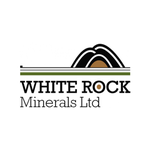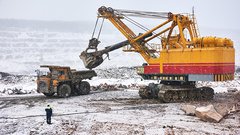New Massive Sulphide Mineralisation at WRM’s Red Mountain High-Grade Zinc Project
Hey! Looks like you have stumbled on the section of our website where we have archived articles from our old business model.
In 2019 the original founding team returned to run Next Investors, we changed our business model to only write about stocks we carefully research and are invested in for the long term.
The below articles were written under our previous business model. We have kept these articles online here for your reference.
Our new mission is to build a high performing ASX micro cap investment portfolio and share our research, analysis and investment strategy with our readers.
Click Here to View Latest Articles
White Rock Minerals’ (ASX:WRM) 2018 exploration program at its 100% owned Red Mountain Zinc Project in Alaska is off to a great start, with early results suggesting that there’s scope for the company to add to its maiden Resource in a meaningful way over the next few months.
The company’s exploration program at the high-grade zinc VMS project is the first undertaken since the 1990s, and it’s now in full swing.
While it’s still early days in the project’s development, the existing JORC (2012) Mineral Resource at Red Mountain already places the project in the top quartile of undeveloped high-grade VMS (zinc, silver, gold) deposits globally.
That Resource currently sits at 16.7Mt at 8.9% zinc equivalent, including a high grade Resource of 9.1Mt at 12.9% zinc equivalent.
Even with this existing globally significant high grade Resource, WRM still has some of the best of the more than 30 already identified regional exploration targets within the 143 square kilometre land package to follow up on.
The focus of WRM’s exploration program this year is to add to the two known deposits (Dry Creek and West Tundra) and expand the maiden Resource, and to identify and test new targets to make additional discoveries.
Encouragingly, the drilling results to date seem to point in that direction, delivering some exceptional intersections, with Resource expansion now firmly on the cards with the latest drilling.
It is, however, early stages for WRM here, so investors should seek professional financial advice if considering this stock for their portfolio.
As reported by the company just today, assay results highlight the upside potential for a significant expansion to the Resource at the project’s Dry Creek prospect, both in terms of grade and size.
And after the latest drill hole intercepts of massive sulphides, WRM anticipates that there may well be further discoveries of more high-grade VMS mineralisation, and it has confidence that the Resource is open down-dip, and in places along strike.
Recent strong conductivity anomaly results using the on-ground geophysics tool CSAMT and their coincidence with known massive sulphide mineralisation means WRM now has a powerful exploration tool to identify new targets for drill testing. The company hopes that this will assist lead to an expansion of the Resource at the project as well as assist in the discovery of new deposits.
The company sees significant discovery potential, particularly due to the lack of modern day exploration at Red Mountain. Drill targeting is now being supported by modern geophysics that have never before been used at the project, namely the CSAMT geophysics exploration tool, in combination with geochem sampling and terrain mapping.
This discovery potential is further enhanced by the very nature of VMS deposits clustering in camps, and the potentially large areas over which these can occur.
White Rock has a market cap of just $10 million, despite the globally significant undeveloped high-grade VMS Mineral Resource at Red Mountain, along with the remaining 30-odd exploration targets to follow up on using modern technology, not to mention the company’s 100%-owned Mt Carrington Gold-Silver Project in NSW that comes with its own JORC Resource and JORC Reserve. So it would seem that there remains plenty of upside yet to be captured by investors.
But before making that conclusion, let’s catch up on all the latest from:
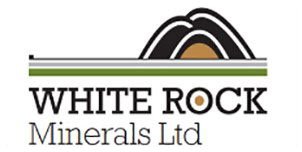
White Rock Minerals’ (ASX:WRM) Red Mountain Project in central Alaska has been the focus of the company’s recent activities, and is the subject of today’s update.
The project is located 100 kilometres south of Fairbanks in Alaska’s Bonnifield Mining District, close to extensive mining infrastructure in a mining friendly jurisdiction and comprises 230 mining claims over a total area of 143 square kilometres.
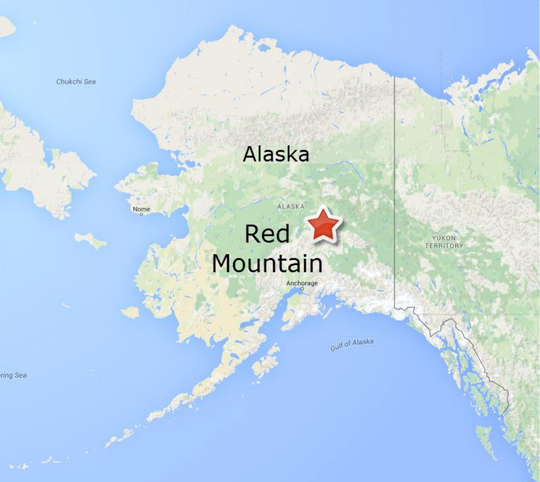
These tenements contain polymetallic VMS mineralisation rich in zinc, silver and lead, along with the potential for significant gold and copper. Notably, the known mineralisation occurs from surface and is open along strike and down-dip.
We last updated you on WRM — and the Red Mountain Project — on May 14 with the article, WRM on Verge of Major Program at Alaskan High-Grade Zinc Project, right as the company was preparing to kick off exploration at the project.
At that time WRM was busy planning a comprehensive and aggressive exploration program aimed at proving up existing deposits and discovering new ones.
This exploration program stemmed from confidence in the project’s potential as it is a high-quality, advanced polymetallic project, located in a region known for its globally significant VMS projects.
WRM already had two known zinc-silver-lead-gold prospects, Dry Creek and West Tundra, and was readying to get the drill bit spinning and regional exploration personnel on the ground as soon as possible.
In the six weeks or so since then, drilling has well and truly kicked off with the goal of expanding the known zinc-silver-lead-gold JORC Resource at Red Mountain and to identify and test new targets to make additional discoveries.
The results that inspired this confidence are detailed below, and were widely reported across a number of news outlets.
The results add support to the existing JORC (2012) Mineral Resource at Red Mountain that places it in the top quartile of undeveloped high-grade VMS (zinc, silver, gold) deposits globally.
Drilling is now targeting extensions to the two existing deposits, Dry Creek and West Tundra, that has an existing Resource that currently sits at 16.7Mt at 8.9% zinc equivalent, including a high grade Resource of 9.1Mt at 12.9% zinc equivalent (using a 3% zinc cut-off grade). This Resource contains 678,000t zinc, 286,000t lead, 53.5 million ounces silver and 352,000 ounces gold.
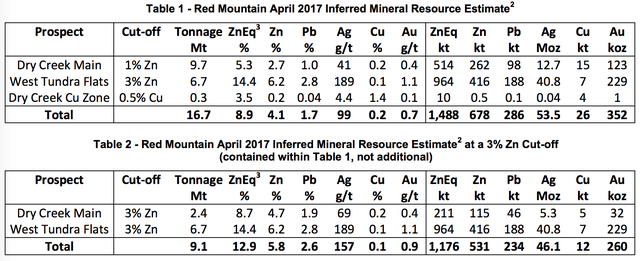
Historical drilling was used by WRM to determine the maiden JORC 2012 Mineral Resource estimate for the Dry Creek and West Tundra deposits.
Initial high grade zinc results at Red Mountain
On June 18, WRM reported initial high-grade drilling results for the Red Mountain Project.
These first drill assay results for the Dry Creek and West Tundra deposits confirmed the company’s earlier suspicions that the two deposits form part of a genuine high-grade zinc rich polymetallic VMS mineralisation system.
The initial drilling and surface mapping and sampling allowed for the mineralisation at Red Mountain to be characterised, and provided the knowledge with which to identify, prioritise and test these targets.
Two of the first three drill holes in the 2018 campaign returned exceptional zinc, lead and silver grades. These included:
- 3.5m at 15.1% zinc, 6.7% lead, 518g/t silver, 2.1g/t gold and 0.2% copper for 35.2% ZnEq (WT18-28).
- 8.9m at 6.5% zinc, 2.7% lead, 124g/t silver, 0.7g/t gold and 0.2% copper for 12.7% ZnEq (DC18-76).
The West Tundra hole (WT18-28) is the best drill hole intersection of all the historic holes drilled into this deposit. Below you can see the WT18-28 drill core showing massive to semi-massive sulphide mineralisation from 60.6 to 64.1 metres (198.9 to 207.1 feet) and 63.9 to 64.1 metres (209.5 to 210.2 feet):
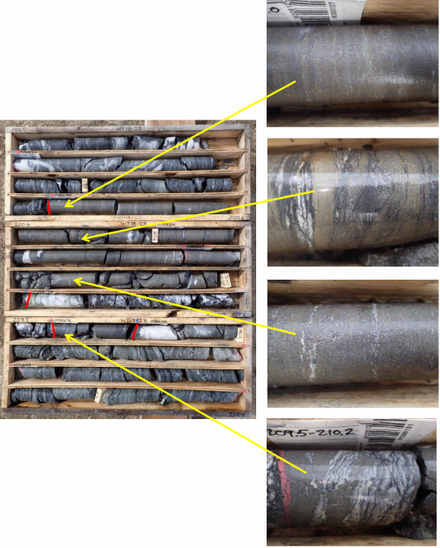
The results are summarised in the table below:
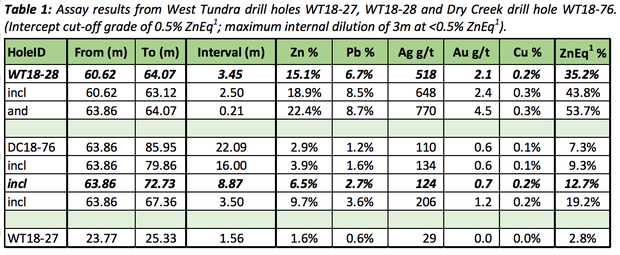
Of course, as with all minerals exploration, success is not guaranteed — consider your own personal circumstances before investing, and seek professional financial advice.
Here’s an overview of those initial assay results, from finfeed.com (a related entity of S3 Consortium):
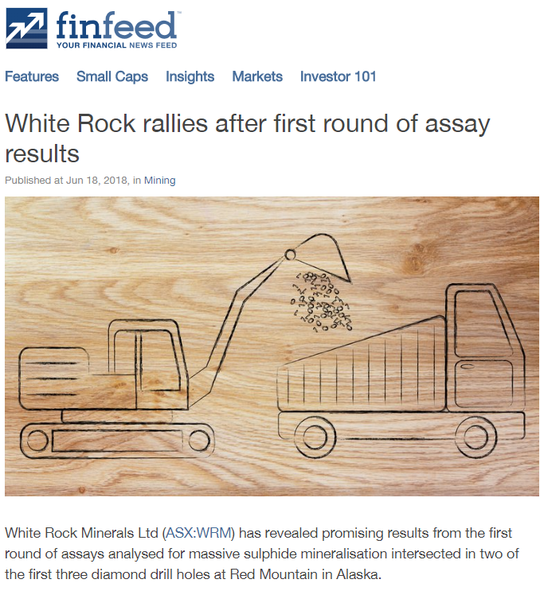
This initial round of drill hole intercepts of massive sulphides supported the argument that there is further potential for the discovery of more high-grade VMS mineralisation and that this Resource is also open down-dip and in places along strike.
This news — that two of the first three diamond drill holes drilled at Red Mountain intersected massive sulphide mineralisation — was reported by news.com.au:
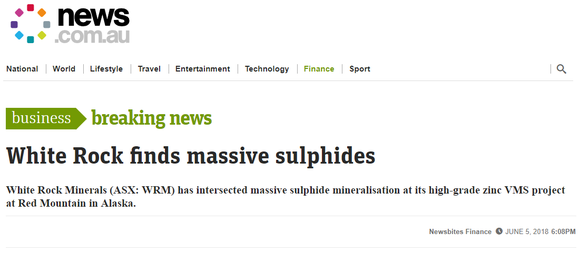
Following news of these high grade intersections, the company found and announced to the market on June 20 that new massive sulphide mineralisation drill intercepts are coincident with geophysics anomalies at Red Mountain.
Orientation geophysics at Red Mountain confirmed that the Dry Creek massive sulphide mineralisation is coincident with strong conductivity anomalies that are identified using both the CSAMT geophysics exploration tool and time domain electromagnetics geophysics.
This modern on-ground geophysics tool (CSAMT) can ‘look’ down into the earth up to 400 metres and so provides a key tool in assisting to identify mineralised structures and where to drill next – a capability no previous explorer had access to.
This is seen as a ‘game-changing’ tool available to White Rock in being able to unlock the exploration discovery potential of this Red Mountain VMS field. Further, modern-day downhole EM geophysics is also available that can ‘look’ up to 70 metres away from the hole — again assisting to guide the exploration program on where to drill so as to increase the Resource size and/or make new discoveries.
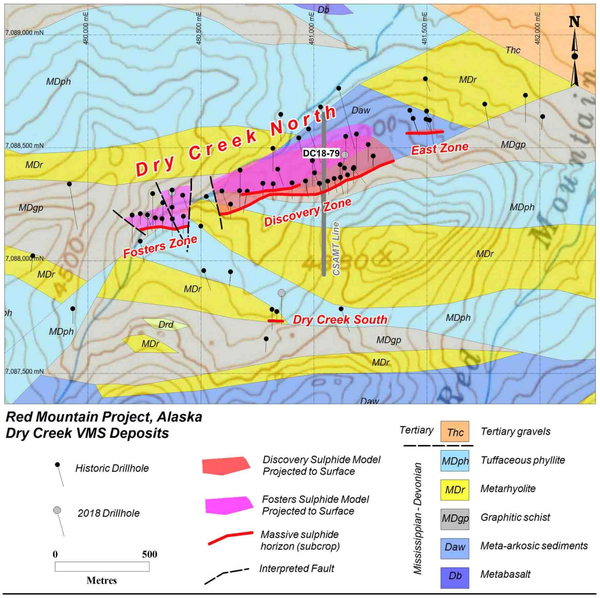
Dry Creek prospect showing surface projection of massive sulphide mineralisation lens’ and the location of DC18-79 with respect to all historic drill hole traces and the orientation CSAMT line on the DGGS geology map.
The stark conductivity anomaly results seen and their coincidence with known massive sulphide mineralisation have ‘delighted’ the company, a sentiment expressed by CEO Matt Gill who explained that WRM was now confident of adding to the project’s maiden Resource in a meaningful way over the next few months.
Mineralisation extended at Dry Creek
On July 4, WRM followed up with further good news. The company announced exceptional assay results for massive sulphide mineralisation intersected in the first two diamond drill holes targeting the down plunge extension of mineralisation in the Discovery lens and the Fosters lens of the Dry Creek deposit at Red Mountain.
The company reported that the Discovery lens interval corresponds with the visible sulphide mineralisation as reported on June 20 and discussed above.
These first two drill holes of the 2018 program to test the down plunge extension of mineralisation at both the Discovery lens and the Fosters lens at the Dry Creek deposit returned exceptional zinc, lead, silver and gold grades, as follows:
- DC18-79 — 4.7m at 19.5% zinc, 7.8% lead, 466g/t silver, 6.9g/t gold and 1.5% copper for 49.7% ZnEq, including 1.6m at 18.5g/t gold.
- DC18-77 — 4.3m at 4.8% zinc, 2.3% lead, 1,435g/t silver, 2.2g/t gold and 0.5% copper for 43.2% ZnEq.
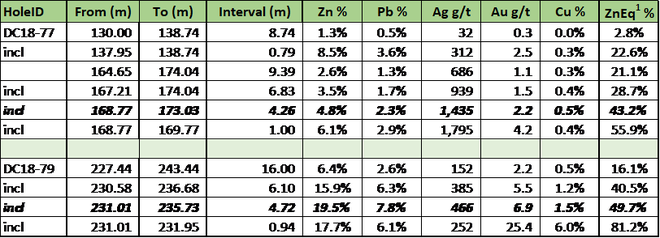
Assay results from Dry Creek drill holes DC18-77 & DC18-79. (Intercept cut-off grade of 0.5% ZnEq; maximum internal dilution of 3m at <0.5% ZnEq).
Here’s DC18-79 drill core showing massive sulphide mineralisation from 230.6 to 236.7 metres (756.5 to 776.5 feet):
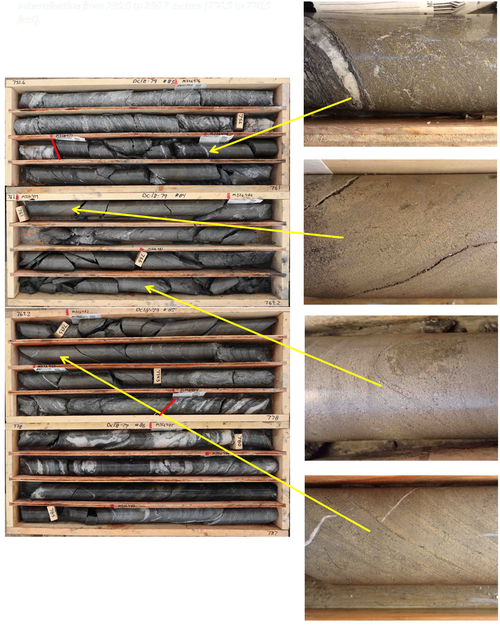
Cross-section 481,115E, below, is looking towards the east through the Dry Creek deposit showing the geometry of the Discovery mineralised massive sulphide lens and the drill intercepts for DC18-79 (yellow trace) and historic drill holes (green traces).
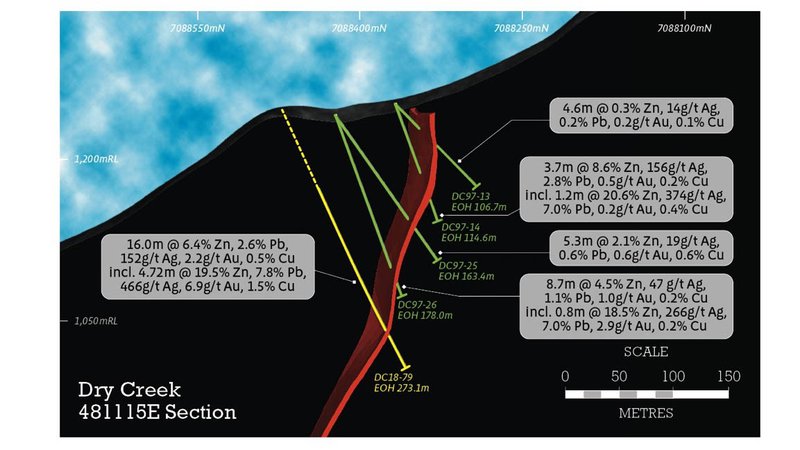
This drilling represents a significant extension to the Dry Creek deposit and notably down dip at both the Fosters and Discovery lenses. These first two extension drill holes highlight the upside potential for a significant expansion to both the Resource grade and size at Dry Creek.

This VMS deposit shows great variation in thickness that has the potential to rapidly add to the Resource, and is open in many directions.
These current drill holes suggest there’s also potential for significant high-grade gold and silver with individual assays up to 25g/t gold and 1,795g/t silver.
Not only that, but WRM is coming across more copper as exploration moves east, supporting an early interpretation that the VMS system may be improving towards the east and at depth, where improving zinc grades could also be expected.
An interesting point to note is that VMS deposits typically occur in clusters, or ‘VMS camps,’ while the deposit sizes within camps typically follow a log normal distribution, and deposits typically occur at regular spacing.
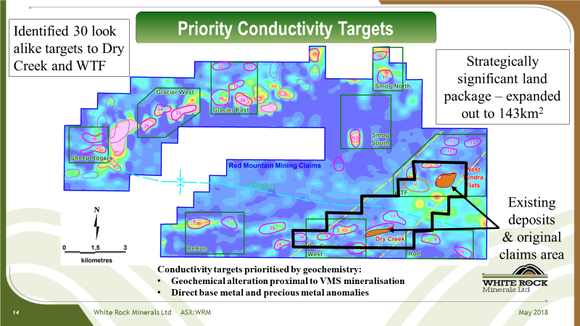
Given the above, the known deposits at Dry Creek and West Tundra provide valuable information with which to vector and target additional new deposits within the Red Mountain camp. Interpreting the geologic setting at Red Mountain indicates conditions exist that could also enhance the prospectivity for gold-rich mineralisation within the VMS system at the project site.
It’s worth noting that gold mineralisation is usually found at the top of VMS base metal deposits or adjacent in the overlying sediments. Additionally, gold bearing host rocks are commonly not enriched in base metals and consequently often missed during early exploration sampling. This provides an exciting opportunity for potential further discoveries at Red Mountain.
Although success is not guaranteed and investors should seek professional financial advice for further information if considering this stock for their portfolio.
And while the geology appears supportive of further upside, so does a comparison with WRM’s peers.
Just days after our last update on the company, WRM published an investor presentation in which the company compared its ‘Enterprise Value per tonne of ZnEq’ in relation to that of its peers:
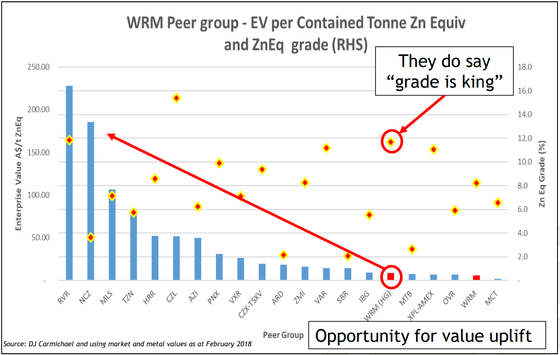
On the basis that “grade is king”, it appears that the company could very well have value that is yet to be realised by investors, or as the presentation noted, “The peer group suggests that WRM has significant potential for a market rerating”.
Furthermore, that calculation excludes any exploration potential at Red Mountain, nor attributes any value to the company’s Mt Carrington gold and silver project in northern NSW.
With plenty of exploration targets remaining (including potentially some of the best), along with a possible Resource expansion and the associated news flow still to come out of Red Mountain — not to mention the company’s Mt Carrington Gold-Silver Project — WRM shareholders could expect to see a lift above the current $10 million market cap.
General Information Only
S3 Consortium Pty Ltd (S3, ‘we’, ‘us’, ‘our’) (CAR No. 433913) is a corporate authorised representative of LeMessurier Securities Pty Ltd (AFSL No. 296877). The information contained in this article is general information and is for informational purposes only. Any advice is general advice only. Any advice contained in this article does not constitute personal advice and S3 has not taken into consideration your personal objectives, financial situation or needs. Please seek your own independent professional advice before making any financial investment decision. Those persons acting upon information contained in this article do so entirely at their own risk.
Conflicts of Interest Notice
S3 and its associated entities may hold investments in companies featured in its articles, including through being paid in the securities of the companies we provide commentary on. We disclose the securities held in relation to a particular company that we provide commentary on. Refer to our Disclosure Policy for information on our self-imposed trading blackouts, hold conditions and de-risking (sell conditions) which seek to mitigate against any potential conflicts of interest.
Publication Notice and Disclaimer
The information contained in this article is current as at the publication date. At the time of publishing, the information contained in this article is based on sources which are available in the public domain that we consider to be reliable, and our own analysis of those sources. The views of the author may not reflect the views of the AFSL holder. Any decision by you to purchase securities in the companies featured in this article should be done so after you have sought your own independent professional advice regarding this information and made your own inquiries as to the validity of any information in this article.
Any forward-looking statements contained in this article are not guarantees or predictions of future performance, and involve known and unknown risks, uncertainties and other factors, many of which are beyond our control, and which may cause actual results or performance of companies featured to differ materially from those expressed in the statements contained in this article. S3 cannot and does not give any assurance that the results or performance expressed or implied by any forward-looking statements contained in this article will actually occur and readers are cautioned not to put undue reliance on forward-looking statements.
This article may include references to our past investing performance. Past performance is not a reliable indicator of our future investing performance.

